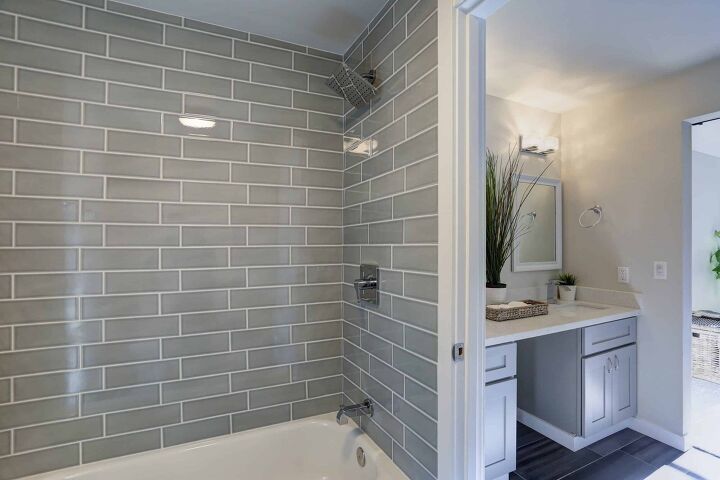How High Should Tile Go In Your Shower?

It is difficult to design and install a shower when you consider how crucial every step is. Everything from the drainage and slope to the showerhead and tiles affect your shower’s performance. With that said, how high should tile go in your shower?
The tile should go up 6’ and 2” high in your shower or higher if you have tall ceilings. There is a suggested minimum height of 6’ tall to protect your walls from water. Tile that extends as high as 74” covers at least ¾ of the shower and affects the functionality and aesthetic of your shower.
Shower tiles can prevent harmful and expensive water damage, so it’s important to install them as high as possible. Follow along as we explore the ideal height for shower tiles for both functional and aesthetic purposes.
Do You Need to Hire Tile Installers?
Get free, zero-commitment quotes from pro contractors near you.

How High Should Tile Go in Your Shower?
The suggested minimum shower tile height is 6’, but shower tile as high as 6’ and 2” is more ideal. Shower tile should extend high enough to parallel the average person’s height. The extra 2” makes a difference, especially if you or someone in your home is particularly tall.
Many builder-owners install shower tile to go as tall as ceiling height. This provides extra splash protection and generally looks better than if the tiles stop before the top of the wall. Lay your shower tiles taller than 6′ to preserve your walls and ceiling.
Calculate Shower Wall Tile
There are several factors, such as ceiling height, that affect how high tile should go in your shower. It is ideal to install shower tile tall enough that it is level with your head. However, many homeowners install shower tiles to extend higher than their heads to protect the walls. Consider the following factors when you calculate how tall our shower tile should be:
- Consider your budget because it can be expensive to install shower tiles as tall as your ceiling. It costs an average of $8 per square foot to install shower tile between installation and labor, but it varies.
- Personal height affects how high your shower tile should go. Install shower tile that extends as the tallest person in your household. You can add another 2”-6” of tile to add extra coverage to protect your wall.
- Building codes generally recommend that you install shower tile a minimum of 6’ tall. This height is enough to cover the average person’s height and prevent splashing. Codes vary between municipalities, so it’s important to check before you lay the tile.
- Wall and ceiling height can determine how tall your shower tile should be. Measure from the floor to the ceiling and install enough tile to reach the ceiling if you can afford it. This may not be possible if you have high ceilings, but tile that extends to the wall offers the best protection.
The two most important factors are building code and height. You want to comply with building codes to avoid fines and penalties. However, you cannot neglect your height because you may damage your wall if the tile stops before your head.
Shower Tile Up to Ceiling
It is ideal to lay tile up to the ceiling if it fits your budget. There are several reasons that it is ideal to tile as tall as your ceiling, such as:
- You can protect your wall and ceiling from water damage if you lay tile to ceiling height. Higher tiles also promote drainage as it helps the water roll down toward your shower drain. Ceiling-height shower tiles are the best way to prevent your shower walls from growing mold.
- Shower tile that extends to your ceiling looks great. A quick look at any interior design magazine will show that floor-to-ceiling tiling can add a spa-like atmosphere to your bathroom.
- Tiling up to your ceiling can make your bathroom look pristine. The improved drainage will help control the moisture. You won’t need to worry about repainting walls that get splashed.
You can still protect your walls and ceiling if you don’t tile up to the ceiling. However, ceiling-height tiles are the best way to preserve both the ceiling and wall to prevent moisture damage.
Shower Layout
Another major issue that people need to take into consideration is the actual layout of your shower. Not all showers and bathtubs are going to be flush against three walls. The location of your shower, the existence (or nonexistence) of a bathtub, as well as the general design of your bathroom can all play a role in your ideal shower tile height. Here’s what you should know:
- Standard Shower And Tubs. If you have a standard bathroom layout that involves a tub and a shower that’s surrounded by walls on three sides, then you can choose to have your tiling hit the ceiling or hit the six-foot level. Either way, it’ll still look good and serve its purpose.
- Walk-In Shower. A walk-in shower that has a glass enclosure usually looks best with tiles that match the enclosure’s height. This is doubly true if you are talking about a shower that’s facing a corner. The only time this is not true is if your shower is an entire “mini room” setup. Then, it’s usually a floor-to-ceiling type of deal.
- Multiple Showerheads. If you have a large shower that has several showerheads facing different directions, then you have a lot more potential for splashing. This means that getting your shower tile to extend up to your ceiling is probably your ideal setup.
What About Tile Size?
If you have larger tiles, that can play a small role in your shower height decision. Larger tiles may need to be cut, which may end up looking somewhat awkward. However, you can always just reduce the height of the tiling and top them off with a row of decorative accent tiles, if you feel like that will look better.
Ask an Expert
For the most part, asking an expert or an interior designer for help is not going to hurt you. If anything, it can give you some good insight into how each height option can work for you and how it’ll look once you’re finished. However, the vast majority of people don’t need to do that. This is purely a matter of personal preference.
How High Should Shower Tile Go Above Shower Head?
The shower tile should go an average of 5” above the showerhead. However, you can comfortably fit shower tiles between 4” and 6” above the showerhead depending on how much space you have between it and the ceiling. Measure the distance between your showerhead and the ceiling before you install the tile.
What Kind Of Tile Should You Use In Your Shower?
There are different standards for each part of your shower goes regarding the type of tile you’re wanting to use. For example, any tile that goes on your shower floor needs to be:
- Impervious to water
- Appropriately sized
- Slip-resistant
For your shower floor, porcelain or certain stone tiles are great options. However, material like glazed ceramic is too slick, unless you get tiles that are super small. While there are not ‘waterproof’ tiles, there are impervious tiles. You will want the most impervious tiles to put on your shower floor.
Shower Wall Tiles
For your shower walls, you need something that’s suitable for moisture and water. For the walls, people use mostly porcelain or glazed ceramic tile. If you want something more unique, you can always use glass or stone for your shower wall as well. However, the glass tiles are very tricky to install as moisture is likely to seep behind them.
If you choose stone, make sure you get stone tiles that are easy to clean. The surface should also be resistant to stains so that you won’t experience any permanent discoloration.
Tiling Your Shower Ceiling
You can choose to either leave your ceiling as is or tile that as well if you experience a lot of moisture on your shower ceiling. Usually, the ceiling tiling will be the same as the walls but it doesn’t necessarily have to be. You can always get creative with your shower space and place some contrasting tiles to accentuate it and add some character.
If you have a steam shower that has a curved ceiling, then the smaller tiles will work better than the larger as they’re more easily to sort of form to the curves of your ceiling. The larger tiles won’t bend and your ceiling will end up looking weird.
Do You Need to Hire Tile Installers?
Get free, zero-commitment quotes from pro contractors near you.

Our Final Take
When it comes to figuring out the layout of your shower tiles, you really only have three options. You can put your tiles to a minimum height of six feet, choose to match the height of your glass doors, or you can decide to go for a ceiling-to-wall layout. With that said, ceiling-high tile layouts tend to have the best durability and visual results in most shower settings.
The thing is, every shower setup is going to be a little different. What looks good in one shower design might look terrible in another, so it’s not fair to give a blanket statement on the optimal shower height. When you’re choosing your tile height, it’s best to take a look at your shower on a holistic level.
Choosing your shower tiling doesn’t have to be a major ordeal. In most cases, people already have an inkling of what they want to do. If you’re still feeling a bit lost, you can always talk to an interior designer or a bathroom remodeling company to help you out. After all, part of their job is designing bathrooms, and that includes figuring out shower tile height.
Related Guides

Ossiana Tepfenhart is an expert writer, focusing on interior design and general home tips. Writing is her life, and it's what she does best. Her interests include art and real estate investments.
More by Ossiana Tepfenhart





















![Standard Dining Room Table Dimensions [for 4, 6, 8, 10 and 12 People]](https://cdn-fastly.upgradedhome.com/media/2023/07/31/9074335/standard-dining-room-table-dimensions-for-4-6-8-10-and-12-people.jpg?size=350x220)


![How To Reset A Whirlpool Cabrio Washer [In 5 Easy Steps!]](https://cdn-fastly.upgradedhome.com/media/2023/07/31/9076531/how-to-reset-a-whirlpool-cabrio-washer-in-5-easy-steps.jpg?size=350x220)


